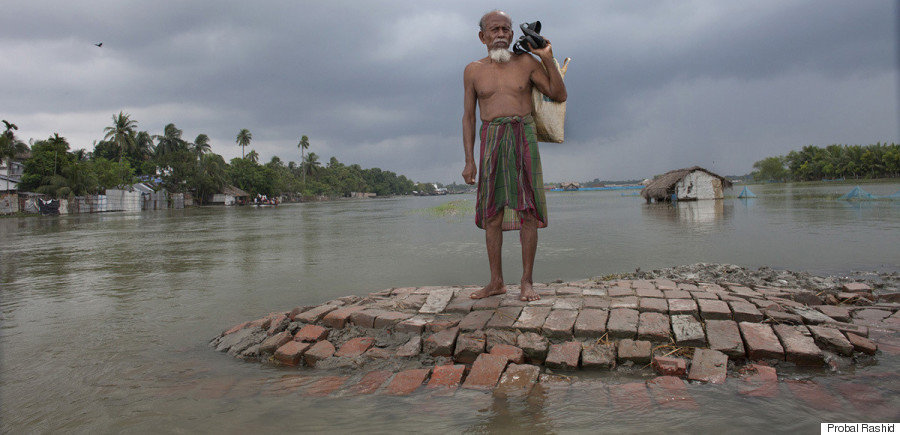In some places, the impact of climate change is already observable. In others, scientists predict the occurrence of climate change based on intricate mathematical and computer models. But in Bangladesh, it is already happening NOW, at a scale that involves unmatched natural and human tragedy. The long history of natural calamities of Bangladesh that used to be a one-in-20-year event now happens once every five years.
“Bangladesh faces particularly severe challenges with climate change threatening its impressive progress in overcoming poverty,” said Johannes Zutt, Former World Bank Country Director for Bangladesh and Nepal.
Being one of the most vulnerable nations to global climate change, it is frequently visited by natural catastrophes such as tropical cyclones, storm rushes, downpours, droughts, hurricanes etc. Superimposed on these disastrous events, climate change and any consequent sea level rise are likely to add fuel to the fire. More frequent storm rushes and tougher cyclones often drive body of water 50 to 60 miles up the Delta’s rivers. The latest devastating flood of 2016 that washed away nearly the whole country was caused by heavy rainfalls as well as water flow from the upstream hills in India and has led to the inundation of the river basin areas,especially in the northern parts of Bangladesh, leaving a large number of people dead, homeless and helpless.
Flood Risk in Bangladesh:
With these natural calamities, also come increased health hazards. Heat waves are distressing many more vulnerable people and global warming is enhancing the transmission of fatal diseases such as malaria and dengue fever. Air pollution from fossil fuel burning is also producing millions of early deaths each year, while the destruction of harvests from extreme weather threatens hunger for millions of children. A World Food Programme (WFP) report says that by 2050, climate change is expected to increase the number of hungry people by 10 to 20 percent, and the number of malnourished children is expected to increase by 24 million—21 percent more than without the effect of climate change.

*Global Flood Analyzer: http://floods.wri.org/#/
Riverbank erosion, in recent years, has yearly displaced between 50,000 and 200,000 people.** The population of “immediately threatened” islands, previously called “chars,” exceeds four million. As soon as chars wash away, the process of deposition creates new chars downstream because of the so dynamic nature of riverine Bangladesh. The land is so unstable and the population so condensed that the displaced people often try to settle on these new, irregular, highly unstable sandbars. A report, prepared for the World Bank by the Potsdam Institute for Climate Impact Research and Climate Analytics and peer-reviewed by 25 scientists worldwide, says that in Bangladesh, 40% of the productive land is projected to be lost in the southern region of Bangladesh for a 65cm sea level rise by the 2080s. About 20 million people in the coastal areas of Bangladesh are already affected by salinity in drinking water. Regarding rising sea levels,
The Guardian report quotes, Saleemul Huq, director of the Bangladesh-based International Centre for Climate Change and Development (ICCCAD) as saying, “In the next 20 years we would expect five to 10 million people to have to move from the coastal areas. The whole country is a climate hotspot, but the most vulnerable area is the coast.”
read more Climate Change Impact to Our Health
It is not just ‘people’ who are affected. The Sundarbans, the largest mangrove forest in the world, a World Heritage Site and shelter to the iconic Royal Bengal tiger, lie in the delta of the Ganges River in Bangladesh and India. Across coastal Bangladesh, sea-level rise, worsened by the conversion of mangrove forest for agricultural production, shrimp farming and local business, has resulted in the loss of hundreds of thousands of acres of mangroves. Accordingly, the number of tigers has plummeted. The prediction of World Wildlife Fund says that the tiger may become extinct. Bangladesh is on the way to lose one of its last natural defences against climate change-induced super-storms.
But the outlook is changing. Bangladesh has progressively developed the countrywide capacity to address climate change impacts. The country has invested more than $10 billion in climate change actions which include increasing the capability of government agencies to respond to emergencies, augmenting the capacity of communities to increase their resilience through Climate Change Adaptation (CCA), Disaster Risk Reduction (DRR) and some prominent mitigation measures playing a vital role on political agenda. Apart from these, building emergency cyclone shelters and resilient accommodation, firming up river embankments and coastal polders and reducing salinity intrusion are some of the practices of the initiatives developed by the Government of Bangladesh in consultation with civil society. Prime MinisterSheikh Hasina’s government established a $400 million ‘Climate Change Trust Fund’ in 2009 from its own resources.
Though Bangladesh is saturated with initiatives and projects related to climate change, it is still facing the tragic consequences which prove again and again that Climate Change is happening NOW! So, funding, capacity and technology at the national level must be accessible in order to implement approaches that effectively address and create a more irrepressible Bangladesh.
** Bangladesh: Main River Flood and Bank Erosion Risk Management Program by Asian Development Bank Technical Assistance Consultant’s Report
Writer Shooha Tabil Bangladesh University of Engineering & Technology (BUET)
